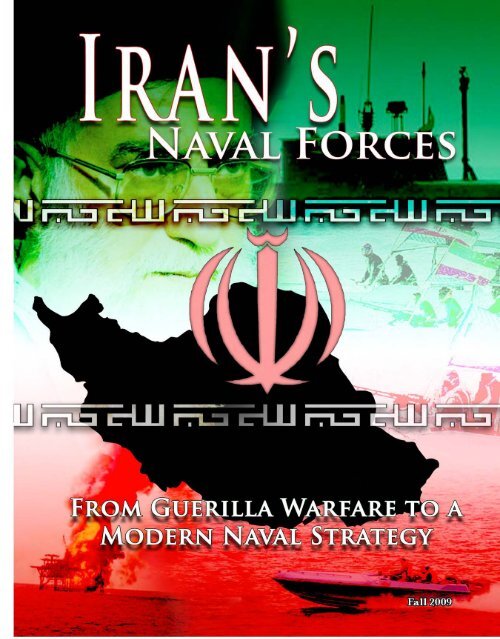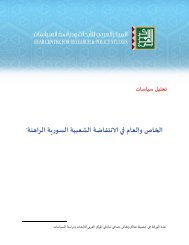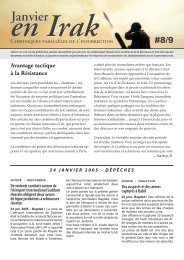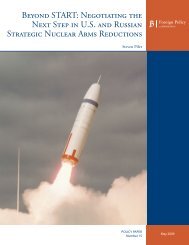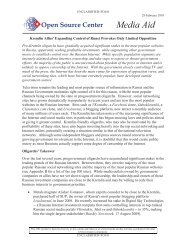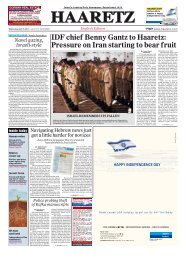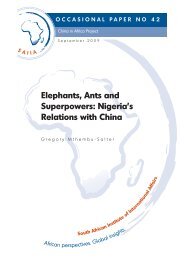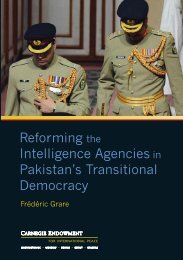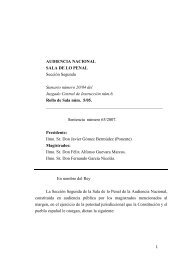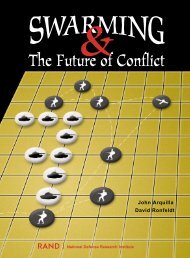Iran's Naval Forces: From Guerilla Warfare to a Modern Naval Strategy
Iran's Naval Forces: From Guerilla Warfare to a Modern Naval Strategy
Iran's Naval Forces: From Guerilla Warfare to a Modern Naval Strategy
You also want an ePaper? Increase the reach of your titles
YUMPU automatically turns print PDFs into web optimized ePapers that Google loves.
Table of Contents<br />
Chapter One: His<strong>to</strong>ry of <strong>Iran's</strong> <strong>Naval</strong> <strong>Forces</strong> and the hnportance of the Strait of<br />
HorlIluz ......................................................................................................................... 1<br />
Brief His<strong>to</strong>ry of <strong>Iran's</strong> <strong>Naval</strong> <strong>Forces</strong> ............................................................................................. 1<br />
Importance of the Strait of Hormuz ............................................................................................ 2<br />
Chapter Two: Iranian <strong>Naval</strong> <strong>Strategy</strong> ......................................................................... 6<br />
His<strong>to</strong>rical Context ........................................................................................................................ 6<br />
Preparing for an Asymmetric War .............................................................................................. 7<br />
Passive Defense ...................................................................................................................... 8<br />
Decentralization .....................................................................................• ............................. 9<br />
Destabilization ....................................................................................................................... 9<br />
Capitalizing on Favorable Geography .................................................................................. 9<br />
The Moral Component .....................................................• .................................................. 10<br />
Political Vic<strong>to</strong>ry Trumps Military Vic<strong>to</strong>ry ........................................................................... 10<br />
<strong>Naval</strong> Reorganization-Increasing Effectiveness ........................................................................ 11<br />
Chapter Three: Procurelll.ent and Acquisition Trends .............................................. 13<br />
Self-Sufficiency ....................................................................................................• ...................... 13<br />
Smaller, Faster, More Numerous Vessels ..................................................................................... 13<br />
Iranian Mines ............................................................................................................................... 16<br />
Coastal Defense Cruise Missiles .................................................................................................. 16<br />
Torpedoes ..................................................................................................................................... 17<br />
Submarines ................................................................................................................................... 17<br />
KILO ..................................................................................................................................... 17<br />
YONO ................................................................................................................................... 18<br />
NAHANG ............................................................................................................................. 18<br />
Iranian Air Defense ...................................................................................................................... 19<br />
Chapter Four: Operations and Readiness .................................................................. 20<br />
Patrols ........................................................................................................................................... 20<br />
Exercises ....................................................................................................................................... 21<br />
Training ........................................................................................................................................ 21<br />
Dispersals ..................................................................................................................................... 21<br />
Intelligence, Surveillance, and Reconnaissance (ISR) ................................................................ 22<br />
IRGCN Small Boat Tactics ......................................................................................................... 22<br />
Small Boat <strong>Warfare</strong>: Advantages and Disadvantages ........................................................... 23<br />
IRGCN Small Boat Employment ......................................................................................... 23<br />
Chapter Five: Outlook .................................................................................................. 24<br />
Submarines ................................................................................................................................... 24<br />
Surface Ships ................................................................................................................................ 24<br />
Weapons ....................................................................................................................................... 25<br />
Changes in <strong>Strategy</strong> ..................................................................................................................... 25<br />
Conclusion .................................................................................................................................... 26
Chapter One<br />
His<strong>to</strong>ry of <strong>Iran's</strong> <strong>Naval</strong> <strong>Forces</strong> and<br />
the Importance of the Strait of Hormuz<br />
Brief His<strong>to</strong>ry of <strong>Iran's</strong> <strong>Naval</strong> <strong>Forces</strong><br />
<strong>Iran's</strong> naval forces, like the country itself, have<br />
been shaped by the Islamic revolution, petroleum,<br />
and an often adversarial relationship<br />
with neighboring countries and the international<br />
community as a whole. These fac<strong>to</strong>rs<br />
have influenced how <strong>Iran's</strong> naval forces are organized,<br />
how they are equipped and manned,<br />
and how they interact with external forces.<br />
Iran has two naval forces: the Islamic Republic<br />
ofIran Navy, or IRIN, and the Islamic<br />
Revolutionary Guard Corps Navy, or IRGCN.<br />
The IRIN is the naval branch of<strong>Iran's</strong> Artesh,<br />
the traditional military force that existed<br />
prior <strong>to</strong> the 1979 revolution. This force was<br />
the former Shah's Imperial Iranian Navy and<br />
was originally designed <strong>to</strong> be a blue-water<br />
force capable of demonstrating the power and<br />
prestige ofthe Shah's Iran. Today, it consists<br />
mainly of older, mid-sized naval combatants,<br />
such as corvettes and missile-equipped patrol<br />
craft purchased by the Shah from western<br />
nations, including the United States, the<br />
United Kingdom, and France. The IRIN<br />
has not fully escaped the stigma of its prerevolution<br />
loyalties and remains secondary in<br />
most respects <strong>to</strong> the IRGCN.<br />
The IRGCN emerged after the Islamic<br />
revolution during the Iran-Iraq War in the<br />
1980s. The revolutionary forces not only<br />
distrusted the former Shah's military, they<br />
greatly weakened it by executing many senior<br />
commanders and conducting purges <strong>to</strong> rid<br />
it of any loyalists <strong>to</strong> the Shah. This allowed<br />
the Islamic Revolutionary Guard Corps<br />
(IRGC)-the Aya<strong>to</strong>llah Khomeini's base of<br />
revolutionaries turned paramilitary internal<br />
security force-<strong>to</strong> take on a larger role in<br />
the country's defense. In addition <strong>to</strong> the<br />
original ground forces element, the IRGC also<br />
formalized an emerging naval component in<br />
the mid-1980s, following successful amphibious<br />
operations in the southern marshlands of Iraq.<br />
Over the intervening decades, the IRGCN has<br />
been politically favored over the IRIN and has<br />
capitalized on this status <strong>to</strong> acquire advanced<br />
weaponry and better platforms <strong>to</strong> develop<br />
additional capabilities.<br />
<strong>Iran's</strong> British-Illade VOSPER-class<br />
corvette, a reIllnant of the Shah's navy<br />
Unlike many countries, Iran does not have a<br />
long naval his<strong>to</strong>ry. The development of <strong>Iran's</strong><br />
naval forces was kick-started by the discovery<br />
of <strong>Iran's</strong> petroleum deposits in the early 20 th<br />
century and the country's subsequent need <strong>to</strong><br />
1
protect its maritime cmnmerce. However, the<br />
Shah's navy operated under the shadow offoreign<br />
forces until the 1970s when British stewardship<br />
in the Persian Gulf came <strong>to</strong> an end.<br />
After the British withdrawal, Iran <strong>to</strong>ok a larger<br />
role in protecting the Persian Gulf sea-lanes,<br />
particularly escorting Iranian merchant ships.<br />
The Shah, awash with oil revenue, provided a<br />
large defense budget and the prmnise of new<br />
equipment with which the navy could carry out<br />
its expanding missions. In line with the government's<br />
cooperative relationship with the West,<br />
the Shah's navy bought frigates, destroyers,<br />
corvettes, and patrol craft and operated them<br />
largely according <strong>to</strong> NATO doctrine. Items<br />
ordered included modified SPRUANCEclass<br />
destroyers and diesel submarines frmn<br />
the United States and Germany. VYhile smne<br />
acquisitions were necessary for the navy's<br />
mission, others were more for the prestige that<br />
came with having one of the strongest navies in<br />
the region. So great were the Shah's ambitions<br />
that a few western countries sought <strong>to</strong> impose<br />
limits on the Shah's quest for regional power.<br />
The Shah's plans <strong>to</strong> dmninate the region's waters<br />
were ultimately terminated by the Islamic<br />
Revolution. In 1979, the Shah was deposed and<br />
the nation was transformed in<strong>to</strong> the Islamic<br />
Republic ofIran, led by Supreme Leader Aya<strong>to</strong>llah<br />
Khmneini. <strong>Iran's</strong> ties with the West and<br />
the defense contracts that came with them were<br />
severed, leaving many Iranian naval aspirations<br />
unfulfilled. However, the remnants of the<br />
Shah's Imperial Iranian Navy survived <strong>to</strong> form<br />
the core of the new Islamic Republic of Iran<br />
Navy.<br />
Soon after the revolution the Iranian naval<br />
forces experienced their most active period.<br />
During the Iran-Iraq War, both belligerents<br />
staged attacks against merchant shipping in the<br />
Persian Gulf. By one estimate, 546 cmnmer-<br />
cial vessels were damaged, most of which were<br />
Kuwaiti vessels attacked by Iran. Iranian naval<br />
forces executed hit-and-run attacks with small<br />
boats, fired naval guns from IRIN warships,<br />
boarded cmnmercial vessels in search of material<br />
destined <strong>to</strong> support Iraq's war efforts, and<br />
attacked merchants using coastal defense cruise<br />
missiles.<br />
<strong>Iran's</strong> use of naval mines during the war was,<br />
however, the most notable aspect of the maritime<br />
front of the war. During the very first escort<br />
mission of re-flagged tankers by U.S. Navy<br />
ships inJuly 1987, the Kuwaiti super tanker<br />
AL REKKAH, re-flagged as the United States<br />
super tanker BRIDGETON, struck a mine.<br />
Two months later, the United States caught the<br />
IRIN's IRAN AJR-class landing ship IRAN<br />
AJR laying mines off the coast of Bahrain.<br />
Then in April 1988, USS SAMUEL B. ROB<br />
ERTS hit an Iranian mine, initiating the<br />
retalia<strong>to</strong>ry Operation PRAYING MANTIS<br />
by U.S. forces. This list is not all-inclusive, and<br />
many other incidents of Iranian mine strikes<br />
occurred throughout the course of the war.<br />
Today, <strong>Iran's</strong> naval forces protect Iranian<br />
waters and natural resources, especially <strong>Iran's</strong><br />
petroleum-related assets and industries. Iranian<br />
maritime security operations guard against<br />
the smuggling of illegal goods (especially<br />
drugs) and immigrants, and protect against<br />
the poaching and stealing of fish in terri<strong>to</strong>rial<br />
waters. Additionally, Iran uses its naval forces<br />
for political ends such as naval diplmnacy and<br />
strategic messaging. Most of all, Iranian naval<br />
forces are equipped <strong>to</strong> defend against perceived<br />
external threats. Public statements by Iranian<br />
leaders indicate that they would consider<br />
closing or controlling the Strait of Hormuz if<br />
provoked, thereby cutting off ahnost 30 percent<br />
of the world's oil supply.<br />
Itnportance of the Strait ofHortnuz<br />
The U.S. Department of Energy estimated that<br />
in 2008 Gulf nations produced 29.8 percent of<br />
the world's oil supply, much of which transited<br />
the Strait ofHormuz. Additionally the Persian<br />
2
The Strait if Hormu;;: is just under 90 nautical miles long and only about 22 <strong>to</strong><br />
35 nautical miles wide. It has two deep-water channels, one eachfor inbound and<br />
outbound trriffic; these two channels are about 1 nautical mile wide.<br />
Gulf region produced 29.1 percent of the<br />
natural gas for export <strong>to</strong> the world's markets.<br />
Closure of the Strait of Hormuz would require<br />
the use of overland routes <strong>to</strong> transport oil<br />
out of the Persian Gulf. Currently the Saudi<br />
Arabia East-West Pipeline has the capacity<br />
<strong>to</strong> move five million barrels per day <strong>to</strong> the<br />
port ofYanbu on the Red Sea, well short of<br />
the average 17 million barrels per day that<br />
currently transit the Strait of Hormuz.<br />
Iran would not be immune <strong>to</strong> the econmnic<br />
impact of a Strait of Hormuz closure. <strong>Iran's</strong><br />
exports of crude oil and petroleum products<br />
alone in 2006 accounted for 74 percent of the<br />
<strong>to</strong>tal value of <strong>Iran's</strong> exports and w ere equal<br />
<strong>to</strong> 29 percent of the nation's gross dmnestic<br />
product (GDP). By volume, roughly 87 percent<br />
of <strong>Iran's</strong> imports and 99 percent of its exports<br />
are by sea. The vast majority of this trade transits<br />
the Strait of Hormuz. Figure 1-1 (page 4)<br />
show s the leading countries for Iranian imports<br />
and exports.<br />
Closing the Strait of Hormuz would cause Iran<br />
tremendous econmnic damage, and therefore<br />
Iran w ould probably not undertake a closure<br />
lightly. However, given the importance of the<br />
Strait, disrupting traffic flow or even threatening<br />
<strong>to</strong> do so may be an effective <strong>to</strong>ol for Iran .<br />
...<br />
...<br />
--<br />
- ......<br />
ElM ....<br />
Major ports in the Persian Gulfregion<br />
3
~<br />
. Germany<br />
El UAE<br />
. France<br />
O ChlAa<br />
• South Korel<br />
1:I 0lher Parinar!<br />
. Japan<br />
OTurkey<br />
. South Korea<br />
O Chlna<br />
. Italy<br />
O Other Panners<br />
<strong>Iran's</strong> Illain trading partners for 2006<br />
iIllpOrtS by value<br />
Figure 1-1<br />
<strong>Iran's</strong> Illain trading partners for 2006<br />
exports by value<br />
The other Persian Gulf countries are also<br />
dependent on trade via the Strait of Hormuz.<br />
Exports from many ofthese countries consist<br />
primarily of crude oil and liquefied natural<br />
gas (LNG) going <strong>to</strong> world markets. The United<br />
Arab Emirates (UAE) ports of Abu Dhabi and<br />
Dubai are the busiest in the region and account<br />
for 88 percent of the UAE's GDP. Most UAE<br />
trade involves these Persian Gulfports and<br />
therefore must transit the Strait. Iraq's import<br />
100%<br />
90%<br />
BO% -<br />
70% -::<br />
60% f- f- f-<br />
50% f- f- f- o Import: I<br />
40% f- f- f- • Exports<br />
30%<br />
20%<br />
10%<br />
", 'M_ Saudi Kuwoil QrI ..<br />
'"<br />
.,<br />
A~I.<br />
IIllpOrts/Exports<br />
as percentage ofGDP<br />
100%<br />
90% I-: r::; r-<br />
BO% f-<br />
70% r-<br />
60% r-<br />
50% f-<br />
II ~ Impo": I<br />
40% • Exports<br />
30%<br />
20%<br />
Percentage of value that 10%<br />
transits the Strait ofHoTIlluZ 0%<br />
..<br />
Figure 1-2<br />
-.<br />
~ sOlla, Kuw"<br />
-<br />
,~<br />
...<br />
4
dependence is less than the other countries in<br />
the region; about 55 percent of its imports by<br />
value come over land from Syria, Turkey, and<br />
Jordan. Figure 1-2 (page 4) shows imports/<br />
exports for Persian Gulf countries (other than<br />
Iran) as percentage ofGDP as well as percentage<br />
of value ofGDP that transits the Strait for<br />
those countries.<br />
The world as a whole, especially industrialized<br />
nations, would experience a serious economic<br />
impact from a sustained closure ofthe Strait<br />
ofHormuz due <strong>to</strong> greatly reduced supplies<br />
of crude oil, petroleum products, and LNG.<br />
According <strong>to</strong> Reuters, ".A.ny military action in<br />
the Strait of Hormuz in the Gulfwould knock<br />
out oil exports from OPEC's biggest producers,<br />
cut off the oil supply <strong>to</strong>Japan and South<br />
Korea, and knock the booming economies of<br />
Gulf states."l In 2007 the Strait of Hormuz<br />
accommodated outbound exports of about 16<br />
million barrels per day of crude oil and refined<br />
petroleum products. These exports amounted<br />
<strong>to</strong> about 40 percent of all seaborne oil exports.<br />
Most of the oil exported via the Strait goes <strong>to</strong><br />
Asia, the United States, and western Europe.<br />
An average of 15 large crude oil tankers per<br />
day transited Hormuz in 2007, as well as other<br />
Dhow typically fOlUld in the Persian<br />
Gulfregion<br />
tankers transporting petroleum products and<br />
LNG. Of note, about 19 percent of global LNG<br />
exports transited the Strait outbound from<br />
Qatar and the UAE in 2007. The importance<br />
of the Strait of Hormuz will likely continue <strong>to</strong><br />
increase over time.<br />
In addition <strong>to</strong> the high volume of energyrelated<br />
maritime traffic, a large volume of<br />
other civilian traffic uses the Strait on a<br />
regular basis. Small local craft, known as<br />
dhows, ply these waters every day. Many<br />
transport a variety of consumer goods<br />
throughout the Persian Gulf and others<br />
are used for fishing. These craft add <strong>to</strong> the<br />
overall volume of traffic crossing the Strait of<br />
Hormuz.<br />
Oil tanker typically fOlUld in the Persian<br />
Gulfregion<br />
1 "FACTBOX: Strait if HOTmu::;: economic q/icts if diJ"TujJtion, "RmteT.f; 7 Jan 2008.<br />
5
Chapter Two<br />
Iranian <strong>Naval</strong> <strong>Strategy</strong><br />
It was during the Iran-Iraq War that Iran<br />
realized the consequences oftechnological<br />
inferiority. According <strong>to</strong> retired Iranian Navy<br />
Rear Admiral Ali-Asghar Kazemi, currently a<br />
professor of political science at Tehran University,<br />
Iran turned <strong>to</strong> a guerilla strategy after<br />
Operation PRAYING MANTIS, a naval<br />
battle between the United States and Iran in<br />
1988, during which the United States sank one<br />
Iranian VOSPER-class corvette (heavily damaging<br />
a second) and one COMBATTANTEclass<br />
guided missile patrol craft. Kazemi said<br />
that the lesson frmn this battle was that, "in a<br />
purely classical naval engagement, the Iranian<br />
Navy would not be able <strong>to</strong> sustain cmnbat<br />
capability and will soon be out of effective<br />
operation."g Iran has incorporated lessons frmn<br />
this conflict and subsequent regional wars such<br />
as Operation DESERT STORM, Operation<br />
ENDURING FREEDOM, and Operation<br />
IRAQI FREEDOM in<strong>to</strong> its naval strategy.<br />
Preparing for an Asytntnetric War<br />
In studying these conflicts, the IRGC decided<br />
that Iran should plan <strong>to</strong> fight an asymmetric<br />
war against potential enemies. According<br />
<strong>to</strong> the IRGC cmnmander, an asymmetric<br />
war would involve "working on all the weaknesses<br />
of the enemy and the maximal usage of<br />
our capability." By choosing an asymmetric<br />
approach, however, Iran is not abandoning<br />
modern military technology. The IRGC<br />
claims that Iran would use its growing arsenal<br />
of modern weapons, including cruise missiles,<br />
modern mines, and submarines, but in a different<br />
way and at a time and place the enemy<br />
would not know or expect.<br />
During the 1990s, the regime sought <strong>to</strong><br />
rebuild frmn the Iran-Iraq War and bolster<br />
its national defenses. The IRGC, the favored<br />
military force due <strong>to</strong> its performance in the<br />
Iran-Iraq War, <strong>to</strong>ok the lion's share ofIranian<br />
<strong>Iran's</strong> VOSPER-class corvette SAHAND<br />
after being attacked by the United States<br />
Navy during Operation PRAYING<br />
MANTIS in 1988<br />
defense funding, increased domestic weapons<br />
production, and ramped up the procurement<br />
of weapons from Russia, China, and North<br />
Korea:l. <strong>Naval</strong> acquisitions included C802<br />
anti-ship cruise missiles (both sea- and landlaunched<br />
systems) and numerous patrol boats.<br />
The IRIN devoted the bulk of its acquisition<br />
funding <strong>to</strong> order three KILO-class attack<br />
submarines. Submarines had long been on the<br />
IRIN's list of desired platforms. During the<br />
Shah's reign, the navy had ordered both U.S.<br />
TANG- and German TYPE 209-class diesel<br />
submarines. Despite the change of regime, the<br />
navy's Shah-era plan <strong>to</strong> acquire submarines<br />
was finally realized.<br />
WIth the receipt of new equipment, Iran<br />
continued <strong>to</strong> develop its naval tactics. Even<br />
the IRIN focused on developing integrated<br />
tactics using several weapons and platforms<br />
simultaneously (including its new submarines,<br />
smaller missile boats, mines, aircraft, and<br />
land-based missile systems) <strong>to</strong> overwhehn an<br />
enemy. Aware of its weakness against a modern<br />
air campaign, Iran also began decentralizing<br />
its cmnmand structure in order <strong>to</strong> decrease its<br />
~ }(ahwqjz; Riad, ''iTan Pirms FOT Attn·tion W(.fT In Cuff," DgmuMw.J, 8 M.ry 2006, P. 1.<br />
~ HagizJ"MnaJ".J, F(.fTiboTZ, PoIigWatciz #1179, ''inm} Doctrineqf A.symmetTicJ/awi W(.fTJ(.fTe," WaJ"izing<strong>to</strong>nlnJ"titutejOT J/iMT EaJ"t<br />
Po!i~y: WaJ"izing<strong>to</strong>nDC., 21 Llfc 2006.<br />
7
In 1988, a U.S. Navy ship,<br />
SAMUEL B. ROBERTS (FFG<br />
58), hit an Iranian mine in the<br />
Persian Gulf. It was only due<br />
<strong>to</strong> extraordinary efforts on the<br />
part ofthe ship's crew that the<br />
frigate did not sink. Mines were<br />
<strong>Iran's</strong> main weapon <strong>to</strong> control<br />
the Persian Gulf and influence<br />
the military supplies transported<br />
<strong>to</strong> Iraq via maritime means.<br />
Since that time, Iran has worked<br />
<strong>to</strong> gain new, more powerful<br />
weapons <strong>to</strong> use against an<br />
enemy force in the Persian Gulf,<br />
the Gulf of Oman, and the Strait<br />
ofHormuz. Iran has continued<br />
<strong>to</strong> update these weapons and<br />
Iranian tactics have evolved <strong>to</strong><br />
make the best use of them as well<br />
as <strong>to</strong> capitalize on the region's<br />
geography. In this pho<strong>to</strong>graph<br />
ROBERTS is seen aboard M/V<br />
MIGHTY SERVANT 2.<br />
reliance on cmnmunications and enable continued<br />
resistance in the event of an attack. Iran<br />
has continued enhancing nearly all its weapons<br />
systems and developing its tactics, watching<br />
and learning from regional conflicts, through<br />
the 1990s <strong>to</strong> the present time.<br />
\Vhile asymmetry is the corners<strong>to</strong>ne of <strong>Iran's</strong><br />
access denial strategy, there are many other<br />
concepts that Iran is incorporating in<strong>to</strong> its<br />
naval construct. Passive defense, capitalizing<br />
on favorable geography, and the primacy of<br />
<strong>Iran's</strong> moral cause are important fac<strong>to</strong>rs in<br />
<strong>Iran's</strong> naval planning.<br />
KILO-class subIllarine acquired during<br />
the 1990s<br />
Passive Defense<br />
In both 1991 and 2003, much ofIraq's defenses,<br />
military infrastructure, and forces<br />
were destroyed early in the conflict by United<br />
States and Coalition air power. Iran appears<br />
<strong>to</strong> understand that its forces must be able <strong>to</strong><br />
withstand such an initial attack in order <strong>to</strong><br />
fight back. Frmn this need for survival, <strong>Iran's</strong><br />
naval forces have developed plans for passive<br />
defense, seeking <strong>to</strong> ensure that assets remain<br />
available after an initial strike. Iran defines<br />
8
passive defense as "a defense without weapons<br />
[which] comprises a range of measures that<br />
reduce vulnerability and increase endurance<br />
against foreign threats."5 Measures such as<br />
camouflage, conceahnent, and deception are<br />
probably key elements in <strong>Iran's</strong> passive defense<br />
plans. Potential examples of these measures<br />
include hiding platforms along <strong>Iran's</strong> coastline,<br />
which is filled with islands, inlets, and coves, as<br />
well as a plethora of oil-related infrastructure.<br />
The IRGC has also built tunnels and underground<br />
bunkers on the Persian Gulfislands<br />
which could provide protection from initial<br />
strikes.<br />
Decentralization<br />
In addition <strong>to</strong> passive defense efforts, Iran has<br />
embraced what it calls a "mosaic defense."<br />
This strategy essentially decentralizes<br />
the command structure, making Iranian<br />
forces more resilient in the face of initial<br />
strikes against their command and control<br />
architecture. According <strong>to</strong> Fariborz<br />
Haghshenass of The Washing<strong>to</strong>n Institute for<br />
Near East Policy:<br />
«Speedboats will be taken out ifcamouflaged<br />
coastal or inland hide sites and<br />
bunkers, hauled on trailers <strong>to</strong> coastal release<br />
points, and given mission-type orders that<br />
will not require them <strong>to</strong> remam in contact<br />
with their chain if command. Each unit of<br />
such teams will be assigned a naval sec<strong>to</strong>r<br />
if operation where, m the event of a conflict,<br />
enemy naval assets or civilian maritime trqf<br />
fie will be attacked."<br />
Destabilization<br />
VYhile controlling the Strait of Hormuz is the<br />
key <strong>to</strong>ol by which Iran could internationalize<br />
any conflict, it has other options as well. Iran<br />
could strike regional countries that actively<br />
support or participate in a conflict against the<br />
Islamic Republic in an attempt <strong>to</strong> dissuade<br />
them from following such a course. According<br />
<strong>to</strong> former IRIN Rear Admiral Ashkbus<br />
Daneh-Kar, "There are numerous ports, oil<br />
terminals, industrial installations and rich<br />
resources in the Persian Gulf area-on the<br />
coastal areas, in the continental shelf and on<br />
the numerous islands. As a result, the Persian<br />
Gulfbecomes specifically a vulnerable target<br />
for special [commando] operations.,,6<br />
«Indeed, I ran's natural geographic advantages provide<br />
the na1!J with the option if seriousfy limiting the<br />
enemy's maneuverability in the Persian Gulf"7<br />
Retired Rear AdmiralAshkbus Daneh-Kar<br />
Islamic Republic ifIranNauy<br />
«Today, the security and tranquility if our country -s sea border is secured because if the se!f-sacrjfiu of na1!J forces<br />
who iffir their lives honestfy and are full-heartedfy rearfy <strong>to</strong> so:foguard the religion and country.»<br />
Major GeneralMostqfa Mohammad-Najjar<br />
Former Minister if Difense and Armed <strong>Forces</strong> Logistics<br />
«In Iran there are people who will not back down when the enemy attacks and they are rearfy <strong>to</strong> be martyredfir<br />
God in resisting the enemy . .. The United States might be the starter if a war, but it will difinitefy not be the one<br />
who ends it.»<br />
Rear Admiral Morteza Sqfari<br />
Commander, Islamic Revolutionary Guard CorpsNa1!J<br />
•<br />
<strong>Iran's</strong> four strategic IllaritiIlle areas<br />
According <strong>to</strong> Fariborz<br />
Haghshenass, Iran relies<br />
on the military's allegiance<br />
<strong>to</strong> the rule of the country's<br />
religious regime, promotes<br />
resilience in the face of<br />
adversity, and glorifies<br />
a culture of jihad and<br />
martyrdom. These ideas<br />
provide an extra dimension<br />
<strong>to</strong> the naval strategy and<br />
may give the Iranian<br />
warfighter extra motivation,<br />
similar <strong>to</strong> the concept of<br />
patriotism for the American<br />
warfighter. Iranian military<br />
leaders often publicly <strong>to</strong>ut<br />
the moral superiority of<br />
<strong>Iran's</strong> fighting forces.<br />
Iran also has developed tactics based on the<br />
water depth and confined nature of the Persian<br />
Gulf. Maneuvering in some parts can be<br />
difficult due <strong>to</strong> the shallow waters more suited<br />
<strong>to</strong> small boats. Also, <strong>Iran's</strong> 1,000 nautical<br />
miles of coastline contains many coves and<br />
marshes in which small boats could hide from<br />
enemy forces. Because the Gulfis less than 100<br />
nautical miles wide in many places, coastal<br />
defense cruise missiles would be able <strong>to</strong> reach<br />
targets in nearby shipping lanes.<br />
The Moral COlll.ponent<br />
A unique, but key, component of <strong>Iran's</strong> concept<br />
of naval strategy is its religious underpinning.<br />
Political Vic<strong>to</strong>ry TrUlll.ps Military<br />
Vic<strong>to</strong>ry<br />
An emerging theory of warfare states that the<br />
world has moved from the third generation<br />
of warfare, consisting oflarge armies moving<br />
against each other, <strong>to</strong> a fourth generation of<br />
warfare in which a smaller force would use<br />
asymmetric tactics <strong>to</strong> survive a conflict against<br />
a technologically superior enemy. According<br />
<strong>to</strong> Colonel Thomas Hammes, author of The<br />
Sling and the S<strong>to</strong>ne, the fourth generation of war<br />
uses "all available networks-political, economic,<br />
social, and military-<strong>to</strong> convince the<br />
enemy's political decision makers that their<br />
strategic goals are either unachievable or <strong>to</strong>o<br />
10
<strong>Naval</strong> Reorganization<br />
Increasing Effectiveness<br />
<strong>Iran's</strong> naval forces continue <strong>to</strong> change<br />
in order <strong>to</strong> better execute their naval<br />
strategy. Since 2007 the IRIN and<br />
IRGCN have been undergoing a<br />
reorganization that has included new<br />
base openings and a re-division of<br />
duties between the navies. Although<br />
the two navies have traditionally<br />
shared operations in the Caspian Sea,<br />
Persian Gulf, and Gulf of Oman, the<br />
reorganization split the IRIN and<br />
IRGCN areas of responsibility. The<br />
IRIN was assigned <strong>to</strong> the Gulf of Oman<br />
and Caspian Sea, while the IRGCN was<br />
given full responsibility for operations in<br />
the Persian Gulf.<br />
Oil platfortns attacked during the Iran-Iraq war<br />
costly for the perceived benefit. It does not attempt<br />
<strong>to</strong> win by defeating the enemy's military<br />
forces. Instead ... it clirecdy attacks the minds of<br />
enemy decision makers <strong>to</strong> destroy the enemy's<br />
political will."B In an effort <strong>to</strong> attack political will,<br />
Iranian leadership has stated that if the United<br />
States <strong>to</strong>ok military action against Iran, "200,000<br />
American soldiers will be seriously imperiled in<br />
the region,"9 and that "the US. Fifth Fleet in<br />
the Persian Gulf would be turned in<strong>to</strong> a 'sea of<br />
fire."'lO Iran is also prepared <strong>to</strong> spread the conflict<br />
beyond the Persian Gulf, and leaders have<br />
publicly stated that Iran would attack American<br />
interests around the world. Iran is aware that a<br />
conflict in the Persian Gulf would make the region<br />
the focus of the world's political considerations.<br />
This reorganization and the<br />
establishment of new bases are in<br />
keeping with Iranian naval strategy in<br />
the event of a conflict. Because <strong>Iran's</strong><br />
naval doctrine is based upon access<br />
denial, the realignment ofIRIN assets<br />
further in<strong>to</strong> the Gulf of Oman and the<br />
concentration ofIRGCN fast boats,<br />
suicide boats, and coastal defense cruise<br />
missiles in the Strait of Hormuz and Persian<br />
Gulfbetter allow Iranian naval assets <strong>to</strong><br />
contribute <strong>to</strong> and extend <strong>Iran's</strong> layered defense<br />
strategy. Throughout the restructuring, senior<br />
commanders in the IRIN and IRGCN have<br />
reiterated that the reorganization of existing<br />
bases and the creation of new bases create a<br />
line of defense that would prevent an enemy<br />
from accessing the Strait of Hormuz and, thus,<br />
the Persian Gulf. IRIN Commander Rear<br />
Admiral Habibollah Sayyari stated that new<br />
IRIN bases will extend from Bandar Abbas,<br />
near the Strait ofHormuz, <strong>to</strong> Pasa Bandar<br />
near the Pakistan border by 2015. Similarly,<br />
IRGCN Commander Rear Admiral Morteza<br />
IHamme.s; TlzomaJ" CoL, TheSlingand TlzeS<strong>to</strong>ne: On WaTin the 2ft Century, ,{enitIzPrm, 2006,p. 2<br />
r TopA1iiitaTyAdoiJ"OT Wanu u.s. AgaimtITanAttaci, "FaTJ" inEngizJ-lz, 20Se}' 2008.<br />
10 ''iTanian A1iiitary EXeTClJ-e 'Creat Prophet JJI' OJ". u.s. )lacy Dn//, "Rmmin Ribao, I 0 pi 2008.<br />
11
infrastructure and resources. At a minimum,<br />
both naval forces may experience smne growing<br />
pains as they assume their new areas of<br />
responsibility.<br />
Rear AdIlliral Morteza Safari<br />
COIllIllander of the IRGCN<br />
Rear AdIlliralHabibollah Sayyari<br />
COIllIllander of the IRIN<br />
Safari described the necessity of creating a new<br />
4th <strong>Naval</strong> District base at Asaluyeh <strong>to</strong> increase<br />
military capability in case of any instability<br />
caused by foreigners in the Persian Gulf. The<br />
goal of the naval reorganization-allowing the<br />
IRIN and the IRGCN <strong>to</strong> operate in accordance<br />
with their relative strengths and thereby better<br />
contribute <strong>to</strong> <strong>Iran's</strong> layered defense strategymay<br />
not be fully realized because of a lack of<br />
The geographic split of the two services not<br />
only streamlines cmnmand and control by<br />
reducing the need <strong>to</strong> coordinate and deconfhct<br />
between different naval services operating in<br />
the same water space, but should also reduce<br />
confusion or miscmnmunication that an enemy<br />
could exploit in wartime. This division of <strong>Iran's</strong><br />
primary bodies of water is logical given the<br />
characteristics ofIRIN and IRGCN ships. The<br />
IRIN operates traditional large warships and<br />
auxiliary ships, which have the endurance and<br />
sea-keeping qualities needed for extended patrols<br />
and missions in open waters. This makes<br />
the IRIN the natural service <strong>to</strong> deploy in the<br />
Gulf of Oman <strong>to</strong> push <strong>Iran's</strong> reconnaissance<br />
as far out as possible and also <strong>to</strong> engage enemy<br />
forces as far away from Iranian terri<strong>to</strong>ry as<br />
possible. The IRGCN operates a force of much<br />
smaller boats, most of which lack the endurance<br />
or configuration <strong>to</strong> remain at sea for more than<br />
a few days. These boats will now operate in<br />
the enclosed waters ofthe Persian Gulf and the<br />
Strait, and will rarely be far from an IRGCN<br />
base.<br />
Locations of <strong>Iran's</strong> new naval district headquarters<br />
The reorganization has not been without challenges.<br />
Although the IRGCN 4th <strong>Naval</strong> District<br />
and the IRIN 2 nd <strong>Naval</strong> District have already<br />
relocated <strong>to</strong> Asaluyeh andJask, respectively, the<br />
new naval bases probably cannot accmnmodate<br />
all of the reallocated assets<br />
because of a lack of<br />
pier space and support<br />
infrastructure. The IRIN<br />
has plans <strong>to</strong> expand these<br />
and other coastal ports,<br />
but the time and resources<br />
required <strong>to</strong> do so mean<br />
that these investments<br />
will payoff only in the<br />
long term.<br />
12
Chapter Three<br />
Procurement and Acquisition<br />
Trends<br />
In order <strong>to</strong> implement its naval strategy, Iran<br />
has engaged in a program <strong>to</strong> develop and acquire<br />
advanced weapons and platforms. <strong>Iran's</strong><br />
defense planning hinges on three motivations:<br />
achieving self-reliance, becoming a regional<br />
power, and maintaining strong deterrent measures<br />
against future attacks. Overall, <strong>Iran's</strong> development<br />
program has strengthened its naval<br />
capabilities, yielding increases in the country's<br />
inven<strong>to</strong>ry of small boats, mines, anti-ship cruise<br />
missiles, <strong>to</strong>rpedoes, and air defense equipment.<br />
Self-Sufficiency<br />
During the Iran-Iraq War embargoes against<br />
Iran inflicted shortages of spare parts, and<br />
many systems becaIIle non-operational as a<br />
result. In order <strong>to</strong> remedy this situation, Iran<br />
developed a CaIIlpaign <strong>to</strong> decrease its reliance<br />
on outside suppliers. These so-called "selfsufficiency<br />
jihads" graduated from manufacturing<br />
spare parts for existing equipment <strong>to</strong> designing<br />
and constructing complete systems almost<br />
entirely in Iran. Although Iran has sought <strong>to</strong><br />
develop its own defense industries <strong>to</strong> reduce<br />
dependence on foreign arms suppliers and<br />
m:in:imize the effect of future arms embargoes, it<br />
is still heavily reliant on military technology support<br />
from North Korea, Russia, and China.<br />
Stnaller, Faster, More Nutnerous<br />
Vessels<br />
While the IRIN is comprised primarily of<br />
aging Shah-era vessels, the IRGCN has continued<br />
<strong>to</strong> purchase and construct new vessels<br />
over the years. The smaller and faster craft<br />
operated by the IRGCN are more suitable <strong>to</strong><br />
the IRGC's mandate <strong>to</strong> protect the revolution.<br />
<strong>From</strong> a naval standpoint this translates in<strong>to</strong> a<br />
focus on coastal waters. For these reasons the<br />
IRGCN has grown <strong>to</strong> be a non-traditional<br />
force, focused on preparing <strong>to</strong> survive any<br />
threat, while incorporating asymmetric and<br />
novel defenses. Moreover, unlike the traditional<br />
naval force of the IRIN, the IRGCN<br />
remains politically favored. This is reflected<br />
in the resources the IRGCN receives <strong>to</strong> build<br />
craft indigenously and <strong>to</strong> seek out suitable technology<br />
from abroad.<br />
As a coastal, more flexible force, the IRGCN began<br />
primarily with small patrol craft, similar <strong>to</strong><br />
fishing or pleasure vessels. However, over time<br />
and with increased funds, the IRGCN sought<br />
out better equipped vessels and technology, often<br />
from abroad. In the mid-l99Os the IRGCN acquired<br />
ten 38-rneter HOUDONG-dass missile<br />
boats from China armed with C802 anti-ship<br />
cruise missiles. Iran also received the Chinesebuilt<br />
C-14-dass missile boat in late 2000. This<br />
l4-meter craft carries short-range anti-ship<br />
cruise missiles and a rocket launcher, and has a<br />
catamaran hull allowing it <strong>to</strong> reach speeds up<br />
<strong>to</strong> 50 knots. Later, in 2006, the IRGCN <strong>to</strong>ok<br />
delivery from China of the MK l3-class patrol<br />
craft also measuring 14 meters but armed with<br />
anti-ship cruise missiles and <strong>to</strong>rpedoes.<br />
13
IRGCN sIllall patrol craft<br />
<strong>Iran's</strong> aggressive move <strong>to</strong>ward self-sufficiency<br />
has been evident in IRGCN vessels like the<br />
PEYKAAP I-class coastal patrol craft and the<br />
PEYKAAP II-class missile boat. Although<br />
both classes are reportedly based on North<br />
Korean designs, Iran indigenously builds and<br />
markets them for export through <strong>Iran's</strong> Maritime<br />
Industries Group (MIG). Despite being<br />
small, measuring 17 meters, the vessels carry<br />
serious firepower. The PEYKAAP II is not<br />
only armed with <strong>to</strong>rpedoes but also the Iranian-made<br />
"Kowsar" anti-ship cruise missile.<br />
IRGCN HOUDONG-class III.issile boat<br />
Since the late 1990s the IRGCN has worked<br />
<strong>to</strong> enhance its small patrol boat inven<strong>to</strong>ry by<br />
purchasing fast boats from Italian speedboat<br />
manufacturer Fabio Buzzi (FB) Design. Besides<br />
purchasing a number of models, which<br />
are based on record-breaking racing boats,<br />
the IRGCN reverse engineered the boats and<br />
began indigenously producing them. like the<br />
PEYKAAP II, the FB boats are marketed for<br />
export by MIG's parent company Defense<br />
Industries Organization (DIO). Advertised<br />
by FB Design with <strong>to</strong>p speeds of 60-70 knots,<br />
these patrol boats give the IRGCN some of the<br />
fastest naval vessels in the Persian Gulf.<br />
IRGCN Chinese-built C-14-class<br />
Illissile boat<br />
Besides more traditional naval craft, the<br />
IRGCN also reportedly is working on incorporating<br />
"unmanned vessels" in<strong>to</strong> its inven<strong>to</strong>ry.<br />
Other world navies operate unmanned vessels;<br />
IRGCN adoption of this modern technology<br />
demonstrates the continued initiative of the<br />
IRGCN <strong>to</strong> increase its naval capabilities.<br />
IRGCN PEYKAAP-class coastal<br />
patrol craft<br />
Other examples of the IRGCN's search for<br />
innovative vessels include the GAHJAE- and<br />
KAJAMI-class semi-submersible craft that<br />
Iran reportedly purchased from North Korea<br />
in 2002. Measuring 15 meters and 20 meters<br />
respectively, these vessels are configured <strong>to</strong><br />
carry two <strong>to</strong>rpedoes each. The ability <strong>to</strong> ahnost<br />
entirely submerge allows the vessels <strong>to</strong> hide<br />
from detection.<br />
14
Table 3 -1: ~aval Order ofUattl ...<br />
Class<br />
:'\'umber in service<br />
KILO 3<br />
YONO (IS-120) 4<br />
NAHANG<br />
I<br />
Swimmer Delivery Vehicle 8<br />
GAI-UAE 3<br />
KpVAMI 3<br />
ALVAND (VOSPER MK 5) 3<br />
BAYANDOR (PF 103) 2<br />
KAMAN (COMBATTANTE II) 14<br />
TONDOR (HOUDONG) 10<br />
C -14 9<br />
MK 13 10<br />
KAYVAN 3<br />
PARVIN (PGM-7I) 3<br />
PEYKAAP II 25<br />
PEYKAAP I 15<br />
US MK III<br />
IO<br />
TIR<br />
IO<br />
US MK II 6<br />
PASHE (MIG-G-1900)<br />
IO<br />
GHAEM (MIG-S-1800) 6<br />
MURCE (MIG-G-0900) 20<br />
SEWART 3<br />
MIL40 2<br />
MIL 55<br />
I<br />
TARLAN 15<br />
KASHDOM II<br />
ASHOORA I (MIG-G-OaOO) 20<br />
B=HAMMER 30<br />
Various Patrol Craft 8<br />
LST 2<br />
IRAN HORMUZ 21 2<br />
HENGAM 4<br />
KARBALA (M IG-S-3700) 2<br />
IRAN HORMUZ 24 3<br />
LIYAN lIO<br />
I<br />
WELLINGTON (M K 4) 2<br />
WELLINGTON (MK 5) 4<br />
IRAN<br />
IO<br />
I<br />
15
The IRGCN continues <strong>to</strong> set itself apart from<br />
the IRIN as its naval vessels primarily consist<br />
of SIllaller, faster platforms that can perform<br />
surreptitious operations while at the same time<br />
carrying significant fIrepower such as C802<br />
anti-ship cruise missiles. The smaller size and<br />
speed ofthe IRGCN's fleet make it ideal for<br />
operations off the Iranian coast and in the<br />
Strait ofHormuz. The ability <strong>to</strong> construct<br />
craft indigenously offers the IRGCN increased<br />
options, as it can work <strong>to</strong> design and fit vessels<br />
that fulfill its operating requirements. It is<br />
likely that the IRGCN will continue <strong>to</strong> replace<br />
aging craft with new construction undertaken<br />
at sites such asJoolalee Marine Industries,<br />
Arvandan Maritime Corporation, and Martyr<br />
Darvishi Marine.<br />
Table 3-1 (page 15) shows a naval order of<br />
battle for <strong>Iran's</strong> naval forces.<br />
Iranian Mines<br />
In addition <strong>to</strong> SIllall boats, <strong>Iran's</strong> credible<br />
mining threat can be an effective deterrent <strong>to</strong><br />
potential enemy forces. The Strait of Hormuz<br />
is a narrow chokepoint that could be mined<br />
effectively in a relatively short amount of time.<br />
Iran uses its mining capability as a strong<br />
deterrent <strong>to</strong> attacks frmn western nations. Such<br />
operations would disrupt or temporarily halt<br />
maritime traffic and harm western econmnies<br />
dependent on Middle Eastern oil exports.<br />
In 1993 Iran entered in<strong>to</strong> negotiations with<br />
China <strong>to</strong> purchase the Chinese-developed<br />
EM52, a rocket-propelled anti-ship mine. The<br />
Iranian purchase of three Russian KILO-class<br />
submarines most likely included modern magnetic,<br />
acoustic, and pressure-sensitive mines. In<br />
addition <strong>to</strong> importing mines, Iran has continued<br />
dmnestic mine production, resulting in a<br />
growing s<strong>to</strong>ckpile of naval mines. As of2004,<br />
U.S. experts estimated that Iran had an inven<strong>to</strong>ry<br />
of at least 2,000 mines.<br />
Currently Iran has a limited number of conventional<br />
naval vessels capable of mine-laying<br />
Mine daIllage <strong>to</strong> USS TRIPOLI after<br />
hitting a ru.ine during the first Persian<br />
Gulf War in February 1991<br />
operations, and thus nonconventional tactics<br />
have been developed enabling Iran <strong>to</strong> deploy<br />
mines using commercial vessels and small<br />
boats. Both the IRIN and IRGCN have been<br />
expanding their capabilities <strong>to</strong> perform minelaying<br />
operations.<br />
Coastal Defense Cruise Missiles<br />
An important layer in <strong>Iran's</strong> defense of the<br />
Persian Gulf and the Strait of Hormuz is its<br />
coastal defense cruise missile (CDCM) capability.<br />
Iran can attack targeted ships with<br />
anti-ship cruise missiles frmn its own shores,<br />
islands, and oil platforms using relatively small<br />
mobile launchers.<br />
The primary missile in the Iranian mobile<br />
CDCM arsenal is the C801/802, first imported<br />
frmn China in 1995. This system augments<br />
16
Iranian coastal defense cruise missile systeIlls<br />
the Seersucker missile system used by Iran in<br />
the Iran-Iraq War. Although the Seersucker<br />
series missile has a greater range and a larger<br />
warhead, the C801/802 missile is capable<br />
of engaging targets at a shorter range of six<br />
nautical miles vice the Seersucker's ten nautical<br />
miles. The C801/802 also boasts greater<br />
accuracy, a lower cruising altitude, and a much<br />
faster set-up time. These capabilities work<br />
<strong>to</strong>gether <strong>to</strong> make this missile a better choice<br />
than the Seersucker for coastal defense within<br />
the narrow waterways along the Iranian coast.<br />
Using the C801l802 alone, Iran can target any<br />
point within the Strait of Hormuz and much of<br />
the Persian Gulf and Gulf of Oman. Lebanese<br />
Hizballah successfully used a C802 missile<br />
<strong>to</strong> target an Israeli naval vessel in 2006; Iran<br />
could use the missile in the same way. Additionally,<br />
Iran has worked jointly with China <strong>to</strong><br />
develop shorter-range missiles, including the<br />
C701, for deployment in narrow geographic<br />
environments.<br />
<strong>Iran's</strong> mobile CDCM launchers can readily<br />
be deployed anywhere along the Iranian<br />
coast and target much of the Persian Gulf and<br />
Gulf of Oman, as well as the entire Strait of<br />
Hormuz. These systems have au<strong>to</strong>-control and<br />
radar homing guidance systems, and some<br />
can target using a remote air link. Through<br />
the deployment of mobile CDCMs combined<br />
with multiple-rocket launchers (MRLs), coastal<br />
artillery, and ballistic missiles, Iran hopes <strong>to</strong><br />
overwhehn enemy air defenses.<br />
Torpedoes<br />
In addition <strong>to</strong> mines and anti-ship cruise missiles,<br />
Iran has a growing <strong>to</strong>rpedo inven<strong>to</strong>ry.<br />
Former Iranian Defense Minister Mostafa<br />
Mohammad-Najjar said in 2007 that Iran had<br />
made great strides in building <strong>to</strong>rpedoes, as<br />
well as anti-missile missiles, radar systems, and<br />
rocketsY As evidence of this progress, in 2005<br />
Iran announced that it had begun production<br />
oftwo types of <strong>to</strong>rpedoes.<br />
Subtnarines<br />
Iran boasts the Gulf's only submarine program.<br />
Iran has three operational classes of submarmes:<br />
the KILO, YONO, and NAHANG.<br />
KILO<br />
Iran has three KILO-class diesel-electric<br />
submarines, all based at Bandar Abbas. These<br />
relatively modern and quiet submarines were<br />
bought from Russia in the 1990s. The fIrst<br />
KILO, TAREQ90l, was commissioned on<br />
21 November 1992. The second KILO, NUH<br />
902, was commissioned on 6June 1993, while<br />
the third KILO, l'UNES 903, was commissioned<br />
on 25 November 1996.<br />
11'lTanianDgell.Je AfimJ-ter Elaborate.!" on Afilitary Capabiiitie.s; " VtJ-ion if the hlamic Republic if ITan}/etwori 2, 13 Feb 2007.<br />
17
Iranian KILO-class suhInarine<br />
Iranian President MahIlloud AhIlladinejad<br />
visiting a YONO-class Illidget suhInarine<br />
Following negotiations <strong>to</strong> upgrade the boats<br />
with Rosoboronexport, the Russian arms<br />
agency, TAREQbegan a refit at Bandar<br />
Abbas in mid-200S. The Russian shipyard<br />
Sevrnash is reported <strong>to</strong> be providing technical<br />
assistance during T AREQs refit. The other<br />
two KILOs are likely <strong>to</strong> undergo refits following<br />
TAREQ Reportedly, an upgrade might<br />
involve the fitting of the submarines with a<br />
cruise missile capable of hitting an adversary's<br />
surface ship or land target at a range of up <strong>to</strong><br />
108 nautical miles.<br />
YONO<br />
Iran also has seven YONO-class midget<br />
submarines (also known as the IS-120,<br />
QADIR, or GHADIR). Hulls 1, 2, and 3<br />
are currently in service, and a fourth was<br />
reportedly launched on 28 November 2007.<br />
A ceremony introducing three additional<br />
YONOs was held on lJune 2009. Iran is<br />
building more of these midget submarines,<br />
and additional YONOs may be launched<br />
in the near future. little is known publicly<br />
about these submarines; however, a video<br />
showing the internal fit of one ofthese boats<br />
suggests that they are equipped with modern,<br />
commercially available navigation and ship<br />
control systems. These boats are likely <strong>to</strong> be<br />
employed in shallow areas of the Gulf, such<br />
as the Strait ofHormuz, and may be used <strong>to</strong><br />
deploy divers.<br />
NAHANG<br />
Iran also has a NAHANG-class midget<br />
submarine, which became operational in 2007.<br />
Iran claims that this 2S-meter submarine<br />
was indigenously designed and built. The<br />
NAHANG reportedly was designed for the<br />
shallow waters ofthe Persian Gulf and may act<br />
as a mothership for swimmer delivery vehicles.<br />
Iranian Air Defense<br />
Iran is concentrating on its ground based air<br />
defense (GBAD) assets and has put a large<br />
amount of financial resources in<strong>to</strong> upgrades<br />
and acquisitions. Recently Iran acquired the<br />
IRIN's NAHANG-class ru.idget subIllarine<br />
18
TOR M-l surface-<strong>to</strong>-air missile (SAM) system<br />
and has shown interest in acquiring the S-300<br />
SAM system from Russia. Aircraft upgrades<br />
appear <strong>to</strong> be lagging behind GBAD acquisitions.<br />
Since the mid-1990s Iran has invested heavily<br />
in its GBAD capabilities, which indicates<br />
that it realizes the most cost-effective way <strong>to</strong><br />
defend itself from an air attack is with GBAD<br />
systems. Most of these systems are located near<br />
key strategic sites, such as military or government<br />
installations. Iran recognizes its limitations<br />
against an air suppression strike, cruise<br />
missiles, or stealth aircraft, and is working <strong>to</strong><br />
increase capabilities in these areas.<br />
Iran announced in December 2007 that it has<br />
contracted <strong>to</strong> purchase an unspecified number<br />
ofS-300s (SA-20) from Russia. The S-300 is<br />
a high-altitude, long-range SAM system that<br />
could significantly increase <strong>Iran's</strong> air defense<br />
capabilities.<br />
In addition <strong>to</strong> SAM systems, Iran operates a<br />
number of anti-aircraft artillery (AAA) and<br />
man portable air defense systems (MAN PADS)<br />
<strong>to</strong> augment its GBAD forces.<br />
Iran purchased 24 Improved HAVVK (1-<br />
HAVVK) air defense systems from the United<br />
States inJuly of 1972 under the code name<br />
PEACE SHIELD. Delivery began in 1976 and<br />
ended on 4 November 1979, when revolutionaries<br />
seized the U.S. Embassy in Tehran. The<br />
I-HAVVK is a medium-range, mobile SAM<br />
system. Due <strong>to</strong> the high numbers originally<br />
delivered, Iran can likely keep a number of<br />
systems operational at any time.<br />
Iran also acquired a small number of the<br />
CSA-l, which is a Chinese copy of the Russian<br />
SA-2 system. The CSA-l is a medium-range<br />
high-altitude SAM system.<br />
The SA-5 is <strong>Iran's</strong> long-range SAM, and<br />
although it is an older system, it is still capable<br />
against modern aircraft. Iran is believed <strong>to</strong><br />
have purchased anywhere from four <strong>to</strong> ten<br />
SA-5 batteries and 25 missiles from the USSR,<br />
and another ten missiles from the Ukraine by<br />
the early 1990s.<br />
In 2006 Iran received the TOR-Ml (SA-15)<br />
from Russia. The TOR-Ml is a very capable<br />
short-range SAM system that can identify 48<br />
targets and simultaneously engage two targets.<br />
19
Chapter Four<br />
Operations and Readiness<br />
The IRIN suffers from the problems inherent<br />
in trying <strong>to</strong> maintain aging western-built<br />
ships without access <strong>to</strong> western support. Most<br />
of the IRIN's surface ships are a combination<br />
of United States, French, and British designs,<br />
and most are more than 30 years old. WIthout<br />
the ability <strong>to</strong> send these ships <strong>to</strong> foreign<br />
ship repair yards or overhaul facilities, Iran<br />
has had <strong>to</strong> maintain them as best as it can<br />
for three decades. Approximately half of the<br />
IRIN's missile-armed surface combatants are<br />
in very poor material condition, limiting their<br />
readiness and operational endurance. Despite<br />
their significant readiness problems, the IRIN<br />
would probably be able <strong>to</strong> get most of its major<br />
combatants <strong>to</strong> sea in a time of crisis or conflict.<br />
The IRGCN operates smaller combatants and<br />
patrol boats, which have much lower maintenance<br />
requirements than the IRIN's large ships<br />
and e:qjoy better overall readiness. Most of the<br />
IRGCN's missile and <strong>to</strong>rpedo boats are less<br />
than ten years old, and should be much more<br />
reliable than the IRIN's older ships and boats.<br />
The IRIN's three KILO-class submarines are<br />
all past the halfway point in their estimated 30-<br />
year lifespan, and have not been sent back <strong>to</strong><br />
Russia for overhaul. As mentioned earlier, Iran<br />
is attempting <strong>to</strong> overhaul KILO SS TAREQ,<br />
the oldest of the three boats, at Bandar Abbas<br />
<strong>Naval</strong> Base, with Russian assistance. Crew<br />
training and materiel readiness are below the<br />
standards of western navies, and IRIN KILOs<br />
are probably not capable of detecting, tracking,<br />
or attacking modern western submarines,<br />
although they should be able <strong>to</strong> defend themsehres<br />
if attacked. Despite their age and need of<br />
overhaul, the IRIN KILOs probably have fair<br />
<strong>to</strong> good readiness levels.<br />
Iranian maritime patrol and strike aircraft are<br />
a mixture of 1970s American designs, such as<br />
the P-3 ORION and the F-4 PHANTOM, and<br />
1970s So.riet aircraft, such as the SU-25. Iran<br />
has managed <strong>to</strong> keep most of its aircraft flying<br />
through cannibalization and probably through<br />
black market acquisition of parts, yet Iranian<br />
aircraft probably suffer from much lower readiness<br />
than most western air forces' aircraft.<br />
Patrols<br />
Despite these readiness problems, Iran conducts<br />
peacetime missions such as maritime<br />
security operations and patrols. Iranian naval<br />
forces in 2008 confiscated ten oil tankers that,<br />
according <strong>to</strong> Iranian press, were smuggling<br />
4,600 <strong>to</strong>ns ofIranian fuel out ofthe Persian<br />
Gulf. Iranian run-ins with western naval<br />
units, notably the capture of 15 British naval<br />
personnel in March 2007, suggest that <strong>Iran's</strong><br />
naval forces are keenly interested in protecting<br />
Iranian terri<strong>to</strong>rial waters. Iranjustified the<br />
seizure of the British personnel by saying that<br />
they had illegally entered Iranian waters. Iran<br />
also claims that its naval forces are conducting<br />
20
extended patrols. In December 2008 Iranian<br />
press reported that Iranian warships were<br />
heading <strong>to</strong> the Gulf of Aden <strong>to</strong> fight the burgeoning<br />
piracy threat in that area; in February<br />
2009 Iranian press reported that the IRIN<br />
had started <strong>to</strong> deploy ships on missions ''<strong>to</strong><br />
the high seas," including a deployment <strong>to</strong> the<br />
Indian Ocean.<br />
Exercises<br />
Both of<strong>Iran's</strong> naval services conduct regular<br />
although little is known about their curricula.<br />
A few IRIN ships are probably employed<br />
ahnost entirely as training ships for cadets and<br />
recruits. The Shah's personal yacht was con-<br />
verted <strong>to</strong> a training ship for use in the Caspian<br />
Sea in 1993. The naval base at Bandar Anzali<br />
exercises, varying in size from a handful of<br />
units conducting simple operations <strong>to</strong> up <strong>to</strong><br />
dozens of units conducting multi-day operations<br />
over a wide area. Most of these exercises<br />
are intended <strong>to</strong> improve military training<br />
and profIciency. These exercises occasion-<br />
ally include test-fires of new weaponry, such<br />
as anti-ship cruise missiles or <strong>to</strong>rpedoes, and<br />
Iran frequently releases media pho<strong>to</strong>graphs or<br />
video of these weapons events. Iran very rarely<br />
conducts exercises with other navies but has<br />
in the past exercised with the Pakistani Navy.<br />
As a result, <strong>Iran's</strong> naval forces would probably<br />
have very poor inter operability with any other<br />
navies in wartime.<br />
At times of heightened tension, Iran conducts<br />
highly publicized naval exercises, the most<br />
notable being the fIrst NOBLE PROPHET<br />
exercise, which was held from 31 March <strong>to</strong><br />
6 April 2006. Iran held additional NOBLE<br />
PROPHET exercises in November 2006 and<br />
July 2008. Each of these exercises featured<br />
extensive coverage in the press and showcased<br />
Iranian weapons and platforms.<br />
Training<br />
The IRIN and IRGCN maintain officer train-<br />
ing schools and specialist training schools,<br />
in the Caspian hosts a naval training center,<br />
and Iranian media have often shown naval<br />
special operations forces training there. IRIN<br />
submarine crews go through a training course,<br />
probably at Bandar Abbas, but little is known<br />
about the curriculum or the attrition rate for<br />
students.<br />
Dispersals<br />
Both the IRIN and IRGCN will likely rely<br />
on dispersal from major bases and facilities<br />
in order <strong>to</strong> improve their survivability<br />
A VOSPER-class corvette firing an anti-ship cruise Illissile<br />
21
An Iranian KILO-class subIllarine and sIllall boats during<br />
an exercise<br />
against attack. The IRGCN's small boats are<br />
especially well suited for dispersals as they are<br />
inherently hard <strong>to</strong> detect and do not require<br />
large piers or deep-water facilities. <strong>Iran's</strong><br />
supplemental ISR, Iran probably maintains<br />
a fairly accurate, timely picture of the mari-<br />
time traffic in its waters. <strong>Iran's</strong> numerous oil<br />
platforms in the northern Persian Gulfprob-<br />
ably provide some supplemental surveillance<br />
capability, either through radars or simple<br />
lengthy coastline, numerous islands, and many<br />
inlets and inland waterways would provide<br />
ample hiding places for most of the IRGCN's<br />
small boats. The IRIN's larger ships would<br />
be less capable of hiding along the shore or in<br />
inland waterways, but would probably attempt<br />
<strong>to</strong> disperse from their major bases <strong>to</strong> smaller<br />
facilities in order <strong>to</strong> avoid detection and attack.<br />
Intelligence, Surveillance, and<br />
Reconnaissance (ISR)<br />
Iran uses a variety of means <strong>to</strong> conduct surveillance<br />
along its coastline and in the Persian<br />
Gulf and Gulf of Oman. The Islamic Republic<br />
ofIran Air Force's P-3F ORION remains<br />
<strong>Iran's</strong> principal maritime patrol aircraft. Other<br />
aircraft that can conduct patrols over water<br />
include the F-27 FRIENDSHIP, the SH-3D<br />
SEA KING, and the Y-12 TURBO PANDA,<br />
but none of these has the endurance of the<br />
ORION and are probably used only for local<br />
patrols. The IRIN's large ships can conduct<br />
surface patrols of up <strong>to</strong> ten days, although<br />
they lack modern surface search radars. The<br />
IRGCN's smaller boats cannot patrol for as<br />
many days as the IRIN's ships but can make<br />
up for their shorter endurance with their much<br />
greater numbers.<br />
Through a combination of traditional and<br />
visual observation of nearby maritime traffic.<br />
The Iranian -held islands in the Strait provide<br />
ideal locations <strong>to</strong> moni<strong>to</strong>r inbound and outbound<br />
maritime traffic, as the traffic separation<br />
scheme passes within a few miles of several<br />
key islands. Finally, there are several hundred<br />
small Iranian boats and dhows afloat on the<br />
Persian Gulf every day, coming and going <strong>to</strong><br />
every corner of the Gulf. Any ofthese boats<br />
could pass ISR information <strong>to</strong> <strong>Iran's</strong> naval<br />
forces by satellite phone or radio.<br />
IRGCN Stnall Boat Tactics<br />
Unlike IRIN tactics-founded on conventional<br />
naval operations during the days of the Shahthe<br />
IRGCN's tactics have grown from a combination<br />
of irregular warfare and ground force<br />
principles. Although the IRGCN has existed<br />
for more than 25 years-growing significantly<br />
more professional and structured during that<br />
22
time-it has eschewed a conventional approach<br />
<strong>to</strong> naval warfare in favor of asytnmetric<br />
tactics and principles of irregular warfare. The<br />
results have been adaptable tactics that leverage<br />
surprise, speed, maneuverability, mass,<br />
and deception, and which ultimately manifest<br />
themselves in hit-and-run style attacks.<br />
Although public statements from Iranian<br />
leadership routinely emphasize their "new"<br />
style of conducting asytnmetric warfare at sea,<br />
IRGCN small boat tactics are neither new nor<br />
original but are typical of his<strong>to</strong>rical small boat<br />
warfare tactics. Thus, in seeking <strong>to</strong> understand<br />
the types of tactics used by the IRGCN, a review<br />
of the basic principles and tactics of small<br />
boat warfare is essential.<br />
Slll.all Boat <strong>Warfare</strong>: Advantages and<br />
Disadvantages<br />
Small boats offer a number of tactical advantages<br />
when operated properly in the lit<strong>to</strong>ral. Most<br />
modern small boats are capable of high speeds,<br />
have very shallow drafts, can be difficult <strong>to</strong> detect<br />
because of their small size, and may not be<br />
positively identified even when detected. These<br />
advantages allow small boats <strong>to</strong> operate in areas<br />
where larger ships cannot, and their high speeds<br />
and greater maneuverability are well suited for<br />
conducting hit-and-i"un style attacks.<br />
VYhile small boats do have several advantages,<br />
they are also constrained by a number of<br />
tactical limitations. For example, small boats<br />
have limited sea keeping capability, limited<br />
operating ranges, and limited endurance. Additionally,<br />
they typically have a relatively small<br />
weapons load-out, little armor or protection for<br />
the crew, and difficulty firing weapons accurately<br />
due <strong>to</strong> platform instability. Thus, small<br />
boats will generally have <strong>to</strong> be close <strong>to</strong> their<br />
target <strong>to</strong> accurately employ their weapons,<br />
will have difficulty employing their weapons<br />
accurately at high speeds or when maneuvering,<br />
and will normally operate near shore or in<br />
shallow waters.<br />
Most small boats conduct hit-and-run style attacks<br />
using surprise or deception, capitalizing<br />
on the surrounding environment. Small boats<br />
consistently attempt <strong>to</strong> use the geography <strong>to</strong><br />
their advantage by engaging targets that are<br />
restricted in their maneuverability, such as vessels<br />
operating in areas of high traffic density,<br />
in straits, or vessels entering or leaving port. In<br />
order <strong>to</strong> exploit these tactical advantages and<br />
attempt <strong>to</strong> overcome their inherent disadvantages,<br />
small boats will most commonly operate<br />
in groups. Operating in groups affords<br />
small boats better combat capabilities through<br />
mutual protection while also increasing their<br />
offensive firepower. Small boat tactics vary<br />
slightly depending on whether they are operating<br />
in large groups, small groups, or independently.<br />
For example, deception and surprise<br />
are more essential for a small boat operating<br />
independently. However, surprise and deception<br />
are more difficult for a large group of<br />
boats <strong>to</strong> achieve, so they will typically rely on<br />
mass and maneuver <strong>to</strong> overwhehn their target,<br />
anticipating that some of the small boats will<br />
penetrate a ship's defenses.<br />
IRGCN Slll.all Boat Elll.ploYlll.ent<br />
The IRGCN has used groups of small boats<br />
since the mid-1980s, conducting a number of<br />
attacks on merchant shipping in the Tanker<br />
War. VYhile generally operating in relatively<br />
small groups, the boats would approach the<br />
targeted vessel <strong>to</strong> very close range and then<br />
fire any number of weapons, which typically<br />
included machine guns and rocket propelled<br />
grenades, in<strong>to</strong> the bridge and crew living<br />
spaces.<br />
Current IRGCN small boat tactics are probably<br />
similar <strong>to</strong> his<strong>to</strong>rical IRGCN small boat<br />
tactics or, at a minimum, utilize the same<br />
principles. There is an abundance of literature<br />
available on IRGCN small boat "swarms,"<br />
some stating that hundreds of boats may be<br />
used <strong>to</strong>gether.<br />
23
Chapter Five<br />
Outlook<br />
Subtnarines<br />
Submarines will probably remain a key feature<br />
of <strong>Iran's</strong> naval order of battle. Iran is the only<br />
country in the Persian Gulf region with sub-<br />
marines, and Iranian naval leaders have stated<br />
publicly that they believe submarines are a bet-<br />
ter value than other weapons systems. The late<br />
Rear Admiral A.shkbus Daneh-Kar wrote that<br />
Iran "calculated the deterrent value of submarines--submarines<br />
could, on a purely self-<br />
sufficient basis, detect surprise attacks launched<br />
from far distances and abort them."12<br />
In keeping with this focus on submarines, in<br />
August 2008 Iran reported that the Ministry<br />
of Defense's Marine Industries Organization<br />
inaugurated the production line of the<br />
QA'EM-class submarine, reportedly a 450-<strong>to</strong>n<br />
submarine. Iran has stated that this new generation<br />
submarine will be built in Iran and will<br />
be equipped with <strong>to</strong>rpedoes, naval mines, and<br />
missiles. According <strong>to</strong> Iran, the QA'EM will<br />
be capable of carrying out both defensive and<br />
offensive operations.<br />
Additionally, the IRIN Commander, Rear<br />
Admiral Sayyari, announced the production<br />
of a submarine of more than 1,000 <strong>to</strong>ns. This<br />
may be yet another submarine for the IRIN in<br />
addition <strong>to</strong> the QA'EM.<br />
Surface Ships<br />
Iran has constructed what it calls the MO\\jclass<br />
destroyer-in fact a corvette-that, once<br />
accepted in<strong>to</strong> service, will probably be employed<br />
in the IRlN's operating area in the Gulf<br />
of Oman. More construction of larger ships<br />
has occurred in the Caspian. Iran announced<br />
that it began a production line of the MO\\j-2<br />
at Bandar Anzali. Also in the Caspian, Iran<br />
has built four copies of its COMBATTANTE<br />
II-class guided missile patrol boat. These construction<br />
programs demonstrate <strong>Iran's</strong> ability<br />
<strong>to</strong> produce mid- <strong>to</strong> large-size ships. Coupled<br />
with <strong>Iran's</strong> continuing interest in self-sufficiency,<br />
these ship-building programs will likely be followed<br />
by others.<br />
Model of a QA'EM-class coastal ,ubruari,,"I<br />
The IRIN is also retrofitting older surface<br />
combatants with upgraded weapons systems.<br />
12Dane/z-Km; .AJ"/zlbl/J; Re(ff .Admiral, "Operational Doctn"ne qftlzeJlao/ qft/ze hlamic Republic qf lrrm, "Sqff, iJ"we}/o. 238, Pi'- 10-12<br />
24
For example, in 2008 Iran announced that it<br />
had installed missiles on one of its patrol craft,<br />
turning it in<strong>to</strong> a guided missile patrol craft.<br />
Iran also substantially upgraded the PF-103-<br />
class patrol ship NAGHDI with missiles. This<br />
type of retrofitting will allow the IRIN <strong>to</strong><br />
extend the usefulness of its aging fleet.<br />
In contrast <strong>to</strong> the IRIN, the IRGCN has concentrated<br />
on acquiring and developing small,<br />
fast boats, some lightly armed and others<br />
armed with missiles and <strong>to</strong>rpedoes, and will<br />
probably continue this trend.<br />
Weapons<br />
<strong>Naval</strong> modernization is one of <strong>Iran's</strong> highest<br />
military priorities and the country continues <strong>to</strong><br />
focus on weapons acquisition and development<br />
programs. Programs of interest include expanding<br />
inven<strong>to</strong>ries of existing weapons systems and<br />
increasingly sophisticated systems. Weapons,<br />
such as the Hoot supercavitation high-speed<br />
missile <strong>to</strong>rpedo, may be proliferated throughout<br />
the Iranian naval inven<strong>to</strong>ry, as will longer<br />
range anti-ship cruise missiles, such as the<br />
Ra'ad. Finally, given the importance of mining<br />
<strong>to</strong> Iranian naval strategy, some effort will<br />
continue in this area as well.<br />
Changes in <strong>Strategy</strong><br />
<strong>Iran's</strong> naval forces are unlikely <strong>to</strong> make wholesale<br />
changes <strong>to</strong> their naval strategy. However,<br />
it is clear that Iran will modify its strategy<br />
when appropriate. Rear Admiral Daneh-Kar<br />
noted that Iranian planners would review and<br />
revise their operational doctrine based on lessons<br />
learned from past and current operations,<br />
as well as on the capabilities of new weapons<br />
systems entering the service. He continued,<br />
"We cannot develop the Navy's operational<br />
doctrine in isolation."13<br />
Recent activity bears witness <strong>to</strong> some of this<br />
adaptation. IRIN commander Rear Admiral<br />
Sayyari has stated that the IRIN will push<br />
operations further out in<strong>to</strong> the Gulf of Oman<br />
and even the Indian Ocean <strong>to</strong> protect <strong>Iran's</strong><br />
maritime interests, and, as mentioned earlier,<br />
Iran claims its naval forces are conducting extended<br />
patrols. A decade hence may see more<br />
frequent IRIN patrols in the north Arabian<br />
Sea or Indian Ocean. To support this, the<br />
IRIN has a plan <strong>to</strong> establish new naval bases<br />
along the Gulf of Oman by 2015 and strengthen<br />
its presence outside the Strait ofHormuz.<br />
The IRGCN will likely continue <strong>to</strong> patrol and<br />
operate inside the Persian Gulf, a place where<br />
Rear Adru.iralHabibollah Sayyari, COIllIllander of the<br />
IRIN, in front of a poster depicting IRIN naval platfoTIlls<br />
HDanelz-Km; .AJ"/zlbuJ" Nar .Admiral, "OpnationaiDoctnne iftlze )lacy if the hlamic Republic if fTan, "Sqff, iJ"J"/uJIo. 235, Pi'- 32-35.<br />
25
its asymmetric tactics and numerous platforms<br />
are at an advantage. However, its modernization<br />
efforts may provide it with more sophisticated<br />
platforms.<br />
Conclusion<br />
«The countries if this region have a sensitive strategic<br />
and geopolitical situation and the Islamu Republic if<br />
Iran can play a considerable role among these countries.<br />
»<br />
General Mohammad-Baqer ,
PUBLISHED BY THE OFFICE OF NAVAL INTELLIGENCE<br />
Correspondence should be sent <strong>to</strong><br />
Senior Intelligence Officer - Iran<br />
4251 Suidand Road<br />
Suidand, MD 20395<br />
oni@Iuuic.naVY.Illil<br />
This report contains copyrighted lllaterial. Copying and disselllinating the<br />
contents are prohibited without the perlllission of the copyright owners.<br />
Copyright perlllission has been sought for those pictures where copyright<br />
was known, and attribution <strong>to</strong> those sources, when known, has been given.


